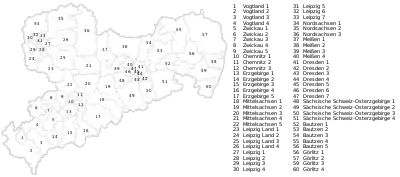Landtag of the Free State of Saxony
The Landtag of the Free State of Saxony, also referred to as the Saxon Landtag, the Parliament of Saxony or the Saxon state parliament, is the legislative body of the German State of Saxony. It is based on the Free State's constitution, drafted in 1992.
Landtag of the Free State of Saxony Sächsischer Landtag | |
|---|---|
| 7th Landtag of Saxony | |
 | |
| Established | September 1831 |
| Leadership | |
President of the Landtag | |
| Structure | |
| Seats | 119 |
 | |
Political groups | Government (67)
Opposition (52) |
| Elections | |
| Mixed-member proportional representation (MMP) | |
Last election | 2019 Saxony state election |
Next election | 2024 Saxony state election |
| Meeting place | |
 | |
| Saxon Landtag (building) | |
History
Some form of an assembly has existed in the state's predecessors since the Saxon House of Wettin was enfeoffed with the Margraviate of Meissen in 1089. The local ministeriales regularly met with the Wettin margraves, consulting but also defending the interests of the region they were from. By the time when Meissen was elevated to the Electorate of Saxony according to the Golden Bull of 1356, the noble representatives of the estates formed a constant advisory board. With the deputies of the Saxon cities, these Landstände councils gradually obtained considerable voice opportunities until the 15th century, mainly in fiscal and military policies, later also in religious matters concerning the Protestant Reformation.
Kingdom of Saxony
A modern-style bicameral constitutionally-based legislature of the Kingdom of Saxony was introduced in September 1831. In the wake of the tumultuous 1848 revolutions, Saxony's Landtag extended voting rights (though still maintaining property requirements) and abolished voting-taxes. In 1871, Saxony was incorporated into the German Empire and more voting rights were gradually extended.
By the early 1900s, Saxony's local politics remained stable with the Social-Democrats, Conservatives, and National-Liberals splitting the share of votes and Landtag seats three ways. (In 1909, Social-Democrats won 27% of seats, Conservatives won 31% and National-Liberals won 31%). Voter participation was high (82% in 1909).
Free State
The post-World War I era saw local politics in Saxony mirror the tumultuousness befalling all of European politics at the time. The Saxon Landtag election of 1930 saw the Social-Democrats winning 33% of seats, the National-Socialists 15%, the Communists 14%, a free-market-liberal party (Reichspartei des deutschen Mittelstandes) 10%, "National-liberals" (Deutschnationale Volkspartei) 8%, and a number of mostly local and right-wing populist parties winning the remaining 16%.[1] Turnout was unenthusiastic, at 73%.
The Landtag elections of 5 March 1933 saw unprecedented turnout of 92%. The National-Socialists won 45%, the Social-Democrats 26%, the Communists 16%, National-liberals (Deutschnationale Volkspartei) 7%, and minor parties taking only 6% of seats. This was the final free election in Saxony until 1990.
Since 1990, the CDU has been in government in the Saxon Landtag and has usually won most of the votes. This changed in 2004.[2]
Electoral System

Elections to the Landtag are conducted using the Mixed-member proportional system using closed lists. In order to qualify for representation a party needs to either win at least two constituencies or gain at least 5% of the statewide party list vote. For determining the constituency winners First-past-the-post voting is used and the overall seat distribution is determined using the D'Hondt method. In the case of overhang seats the total number of seats is increased from the default 120 (60 constituency seats and 60 party list seats) until no overhang seats remain or the number of added seats equals the original number of overhang seats. There is also a provision that if a party wins an absolute majority of the relevant party votes but does not win an absolute majority of seats an extra seat is awarded to that party at the expense of the other parties.[3]
Current Composition
The results of the 2019 Landtag elections were as follows:
< 2014 ![]() Next >
Next >
| Party | Ideology | Votes | Votes % | +/- | Seats | +/- | Seats % | |
|---|---|---|---|---|---|---|---|---|
| Christian Democratic Union (CDU) | Christian democracy | 695,560 | 32.1% | 45 | 37.8% | |||
| Alternative for Germany (AfD) | German nationalism | 595,671 | 27.5% | 38 | 31.9% | |||
| The Left (Die Linke) | Democratic socialism | 224,354 | 10.4% | 14 | 11.8% | |||
| Alliance '90/The Greens (Grünen) | Green politics | 187,015 | 8.6% | 12 | 10.1% | |||
| Social Democratic Party (SPD) | Social democracy | 167,289 | 7.7% | 10 | 8.4% | |||
| Free Democratic Party (FDP) | Liberalism | 97,438 | 4.5% | 0 | 0% | |||
| Free Voters | Direct democracy | 72,897 | 3.4% | 0 | 0% | |||
| Others | 126,233 | 5.8% | 0 | 0% | ||||
| Total | 2,166,457 | 100.0% | 119 | 100.0% | ||||
| Blank and invalid votes | 22,029 | 1.02% | ||||||
| Registered voters / turnout | 3,288,643 | 66.5% | ||||||
References
- https://www.wahlen-in-deutschland.de/wlSachsen.htm ′′Wahlen in Deutschland(in german)
- https://www.wahlen-in-deutschland.de/blSachsen.htm ′′Wahlen in Deutschland/Bundesrepublik′′(in german)
- "Wahlsystem der Landtagswahl 2019 in Sachsen". wahlrecht.de (in German). Retrieved 2020-02-25.